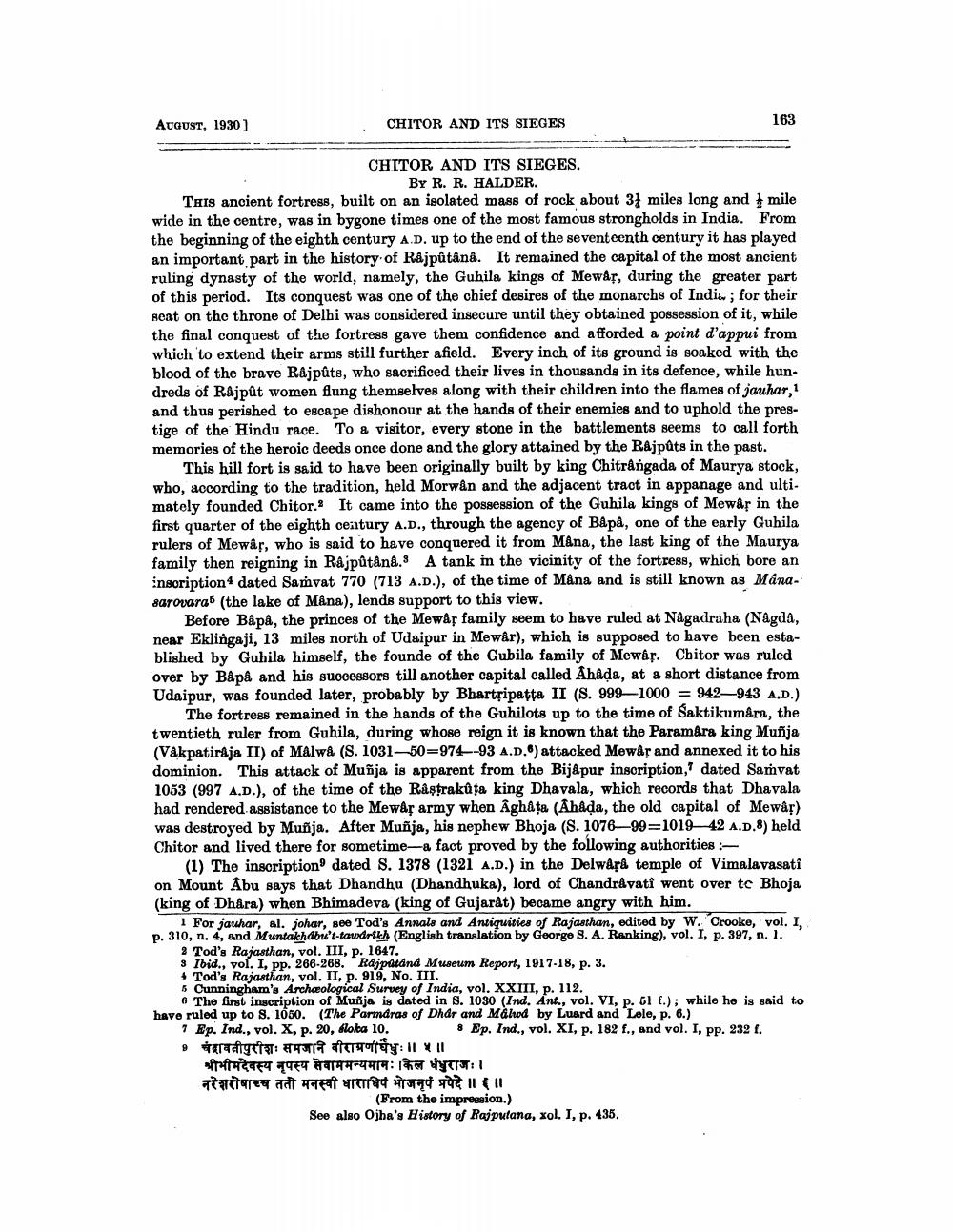________________
AUGUST, 1930)
CHITOR AND ITS SIEGES
163
CHITOR AND ITS SIEGES.
BY R. R. HALDER. This ancient fortress, built on an isolated mass of rock about 37 miles long and 1 mile wide in the centre, was in bygone times one of the most famous strongholds in India. From the beginning of the eighth century A.D. up to the end of the seventeenth century it has played an important part in the history of Rajpûtânâ. It remained the capital of the most ancient ruling dynasty of the world, namely, the Guhila kings of Mewar, during the greater part of this period. Its conquest was one of the chief desires of the monarchs of India; for their Heat on the throne of Delhi was considered insecure until they obtained possession of it, while the final conquest of the fortress gave them confidence and afforded a point d'appui from which to extend their arms still further afield. Every inch of its ground is soaked with the blood of the brave Rajpûts, who sacrificed their lives in thousands in its defence, while hun. dreds of Rajput women flung themselves along with their children into the flames of jauhar, and thus perished to escape dishonour at the hands of their enemies and to uphold the prestige of the Hindu race. To a visitor, every stone in the battlements seems to call forth memories of the heroic deeds once done and the glory attained by the Rajputs in the past.
This hill fort is said to have been originally built by king Chitrangada of Maurya stock, who, according to the tradition, held Morwân and the adjacent tract in appanage and ultimately founded Chitor. It came into the possession of the Guhila kings of Mewar in the first quarter of the eighth century A.D., through the agency of B&på, one of the early Guhila rulers of Mewâr, who is said to have conquered it from Mana, the last king of the Maurya family then reigning in Rajputana. A tank in the vicinity of the fortress, which bore an inscription dated Samyat 770 (713 A.D.), of the time of Mana and is still known as Manasarovarao (the lake of MAna), lends support to this view.
Before Bapa, the princes of the Mewar family seem to have ruled at Nagadraha (Någda, near Eklingaji, 13 miles north of Udaipur in Mewår), which is supposed to have been established by Guhila himself, the founde of the Gubila family of Mewar. Chitor was ruled over by Bapa and his successors till another capital called Ahada, at a short distance from Udaipur, was founded later, probably by Bhartripatta II (S. 999-1000 = 942–943 A.D.)
The fortress remained in the hands of the Guhilots up to the time of Saktikumara, the twentieth ruler from Guhila, during whose reign it is known that the Paramara king Muñja (VÅkpatiraja II) of Malwa (S. 1031-50=974-93 A.D.) attacked Mew&s and annexed it to his dominion. This attack of Muñja is apparent from the Bijapur inscription,' dated Samvat 1053 (997 A.D.), of the time of the Râştrakūta king Dhavala, which records that Dhavala had rendered assistance to the Mewâr army when Âghåța (Ahada, the old capital of Mewâr) was destroyed by Muñija. After Muñja, his nephew Bhoja (S. 107699=101942 A.D.8) held Chitor and lived there for sometime-a fact proved by the following authorities -
(1) The inscription dated s. 1378 (1321 A.D.) in the Delwara temple of Vimalavasati on Mount Abu says that Dhandhu (Dhandhuka), lord of Chandravats went over te Bhoja (king of Dhara) when Bhimadeva (king of Gujarat) became angry with him.
1 For jauhar, al. johar, see Tod's Annals and Antiquities of Rajasthan, edited by W. Crooke, vol. I, p. 310, n. 4, and Muntakhabre't-tawdrikh (English translation by George S. A. Ranking), vol. I, p. 397, n. 1.
2 Tod's Rajasthan, vol. III, p. 1647. 3 Ibid., vol. I, pp. 266-268. Rajputand Museum Report, 191 7-18, p. 3. 4 Tod's Rajasthan, vol. II, p. 919, No. III. 5 Cunningham's Archaeological Survey of India, vol. XXIII, p. 112.
6 The first inscription of Muñija is dated in S. 1030 (Ind. Ant., vol. VI, p. 61 f.); while he is said to have ruled up to S. 1060. (The Parmdras of Dhar and Mäled by Luard and Lele, p. 6.) 7 Ep. Ind., vol. X, p. 20, sloka 10.
8 Ep. Ind., vol. XI, p. 182 f., and vol. I, pp. 232 . tardiger: dray:11 II श्रीभीमदेवस्य नृपस्य सेवाममन्यमामः किल धंधुराजः। नरेशरोषारच तती मनस्वी धाराधिप भोजनृपं प्रपेदे ॥6॥
(From the impression.) See also Ojha's History of Rajputana, xol. I, p. 435,




